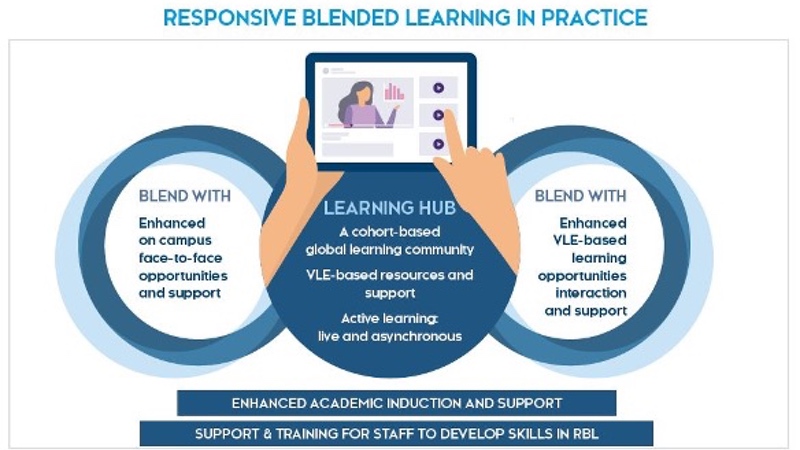Published:

This is the second in the series of weekly Staff Newsletter articles in which I highlight some of the key decisions and developments that will shape how we will be delivering learning and teaching across the University in the new academic year.
This week’s topic – Responsive Blended Learning.
How will we be teaching and supporting student learning next academic year?
As the disruption caused by the Covid-19 pandemic continues, Universities across the world have been grappling with the question of how to offer teaching and learning support to students in Academic Year 2020/21 and beyond.
The majority are adopting an approach which blends face to face with online activities. We will be doing the same. But our particular approach has been designed specifically to enable us to meet the needs of our students and staff operating as one global University. We call it Responsive Blended Learning.
What is Responsive Blended Learning?
Responsive Blended Learning combines online and on-campus elements. Students across the University are provided with access to a core set of online resources and support via the Virtual Learning Environment (Vision). These are supplemented with additional campus-based learning support, as and when that becomes possible, i.e. as and when our different campus locations are able to open.
Critical to the success of Responsive Blended Learning are the steps we take to create an active learning community of which our students feel part wherever they are located and however they engage with their learning.
What is it responsive to?
The approach we are taking has been designed to respond to the changing circumstances under which staff and students will be working. For example, we need to anticipate the possibility that one, or more, of our campuses may be required to go into Covid-19 ‘lockdown’ at short notice at some point in the future. This approach also enables us to respond to the requirements of students whose learning has been disrupted, and to the ongoing wellbeing needs of our staff and students.
Is this a temporary fix?
Whilst Responsive Blended Learning is a pragmatic approach to an extraordinary situation it is not a temporary ‘fix’ for a temporary problem. It builds on existing practice across the University, giving impetus to pedagogic developments – for example, on approaches to teaching and assessment - which were already being pursued before the Covid19 pandemic as part of Heriot-Watt’s learning and teaching strategy.
From a student perspective, what are the benefits of this approach?
Students will benefit from the resilience of this approach. The University will continue to offer education globally enabling them to proceed with their studies alongside their peers, whatever pandemic-related work and travel restrictions are lifted or imposed in specific locations throughout the year. They can therefore start the year with confidence in the expectation that they will be able to proceed through to the next stage of study or on to graduation and future employment. A short video explaining the Responsive Blended Learning approach has been prepared for our new and continuing students.
What support is available to staff preparing for next academic year?
At the School level, Directors of Learning and Teaching and their teams are creating discipline specific resources and guidance building on existing teaching practice.
At University level, the Learning and Teaching Academy has created a comprehensive set of resources to assist staff in their teaching preparation for next academic year. As well as guides, templates and other practical tools, an Introducing Responsive Blended Learning module is available. This is open to all academic and professional services staff who support learning and teaching in any way. It can be studied as a ‘linear’ module, worked through from beginning to end. Alternatively it has been designed to enable individuals to ‘dip in’ and engage with specific resources as and when they are needed.
Conclusion
The experience of Covid-19 reminds us that we cannot anticipate what life will be like in six months or even a year. An enormous amount of work is under way. However, the ingenuity, creativity and care shown in dealing with the Covid-19 disruption to date give us confidence that Academic Year 2020/21 will be an engaging and inspiring one for our whole University community.